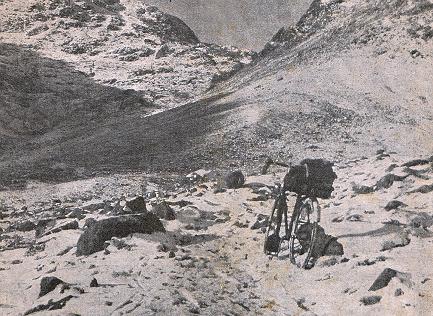touring
>pass
storming
the tandem
|
 The
picture on the left shows Les Nelson and Dick Whinnerah in 'St Johns in
the Vale', a lovely alternate route to Keswick, via
CastleRigg Stone Circle. The
picture on the left shows Les Nelson and Dick Whinnerah in 'St Johns in
the Vale', a lovely alternate route to Keswick, via
CastleRigg Stone Circle.Pass storming
was in vogue in the 1930's-40's, well before mountain bikes and '20-odd'
gears (in fact our dynamic duo were still mainly on fixed wheel).
This involved riding your bike when you
could, and carrying it when you couldn't, over some of the steepest most
inhospitable places in the Lake District.
A book of the time (The Lake District
by Ward, Locke & Co.) had the following advice for cyclists with regard
to the Lake District Passes...
"Those who are only acquainted with
Honister, the Kirkstone, Whinlatter, Buttermere Hause, Dunmail Raise and
even Wrynose and Hardknott are warned that for the most part, the passes
are not metalled roads, or even cart tracks, but mountain paths, some of
which are exceedingly rough and in places steep, e.g. the Sty, Coledale,
and, worst of all, Rossett Ghyll.
Kirkstone Pass, Honister, Buttermere Hause, Whinlatter Pass and Dunmail
Raise are all rideable. Hardknott and Wrynose Pass are negotiable,
but the surface is very bad. The descent from the Garburn
Pass toward Windermere could be ridden in parts. The others are
emphatically not rideable. Many cyclists have carried their
machines over Scarf Gap and even the Sty and Esk Hause, but that game is
a thing apart and known as pass-storming"
It's worth remembering that road
surfaces have changed since the 1930-40's. One of my favourite
rides takes me
up the Duddon Valley and over Wrynose Pass (from the Cockley Beck
side). When the ride over Wrynose was done in the 1940's,
the army used the area for tank practice and the road was basically a
series of foot deep ruts, gouged out by the tank tracks, and for the
most part unrideable. That same book begins its account of Wrynose Pass
as follows...
"We begin the ascent of Wrynose by
one of the worst roads practicable for vehicles in the district..."

Another club run - this
time at the Kirkstone Pass Inn (still there and well worth a visit) via
Ambleside and the aptly named 'Struggle'.
Joan is third from the
right (at the front), Les taking the photo.
|
Below is a list of some of the passes that Joan and
Les 'stormed' together.
| Dunmail Raise |
782 feet |
| Whinlatter Pass |
1,043 feet |
| Buttermere Hause |
1,096 feet |
| Honister Pass |
1,190 feet |
| Wrynose Pass |
1,270 feet |
| Hardknott Pass |
1,290 feet |
| Scarf Gap |
1,400 feet |
| Garburn Pass |
1,450 feet |
| Kirkstone Pass |
1,476 feet |
| Stake Pass |
1,576 feet |
| Sty Head |
1,600 feet |
| Scardale |
1,750 feet |
| Black Sail |
1,800 feet |
| Coledale |
1,800 feet |
| Grisedale |
1,929 feet |
| Gatescarth |
1,950 feet |
| Walna Scar |
1,990 feet |
| Greenup Edge |
1,995 feet |
| Rossett Ghyll |
2,000 feet |
| Nan Bield |
2,100 feet |
| Windy Gap |
2,200 feet |
| Sticks Pass |
2,420 feet |
| Esk Hause |
2,490 feet |
|

At the foot of Rosset Ghyll, with Esk Hause in
the distance
and a light dusting of snow on the ground - on the way
over to Sty Head and Wastwater.
Les reckons this
was one of the hardest runs he ever did.
They rode out from Ulverston to Dungeon Ghyll (Great Langdale),
up Rosset Ghyll (with Les carrying his own bike then coming back
for Joans), up to Esk Hause, Sty Head and then on down to
Wastwater.
They then rode back from Wastwater, over Birker Fell, down the
Duddon Valley to Broughton and home to Ulverston. |
and
some of the runs that included these passes...
Dungeon Ghyll,
ROSSET GHYLL
(2,000 feet), ESK HAUSE (2490 feet),
STY HEAD (1600 feet), Wastwater
(see
picture above).
-
Patterdale,
STICKS PASS (2420 feet), Thirlspot.
Kentmere,
NAN BIELD (2100 feet), Hawes Water.
Coniston,
WALNA SCAR (1990 feet), Seathwaite.
Kentmere,
GARBURN PASS (1450 feet), Troutbeck.
Cockley Beck,
HARDKNOTT (1290 feet), Boot, Eskdale.
Langdale,
WRYNOSE PASS (1270 feet), Cockley Beck.
Remember with the last
two (Hardknott and Wrynose) that these were dirt tracks then, not the
paved roads we know today.
|
|